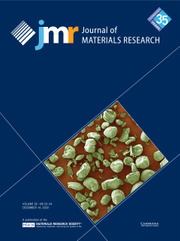Crossref Citations
This article has been cited by the following publications. This list is generated based on data provided by
Crossref.
Tao-Chih Chang
Min-Hsiung Hon
Chin-Hui Chang
and
Moo-Chin Wang
2001.
Effect of heat treatment on the interfacial adhesion strength between Sn-Zn-xAg lead-free solders and Cu substrate.
p.
216.
Chen, Kang-I.
and
Lin, Kwang-Lung
2002.
The microstructures and mechanical properties of the Sn-Zn-Ag-Al-Ga solder alloys—the effect of Ag.
Journal of Electronic Materials,
Vol. 31,
Issue. 8,
p.
861.
Yu, Shan-Pu
Wang, Hsin-Chien
Wang, Moo-Chin
and
Hon, Min-Hsiung
2002.
Effect of composition and thermal cycling on the adhesion strength of Sn-Zn-Al solder hot-dipped on Cu substrate.
Journal of Materials Science,
Vol. 37,
Issue. 1,
p.
185.
Bae, Kyoo-Sik
and
Kim, Si-Jung
2002.
Microstructure and adhesion properties of Sn–0.7Cu/Cu solder joints.
Journal of Materials Research,
Vol. 17,
Issue. 4,
p.
743.
Tao-Chih Chang
Min-Hsiung Hon
Moo-Chin Wang
and
Dong-Yih Lin
2002.
Thermal fatigue resistance of the Sn-9Zn-xAg lead-free solders/Cu interface.
p.
307.
Chang, Tao-Chih
Wang, Moo-Chin
and
Hon, Min-Hsiung
2003.
Crystal growth of the intermetallic compounds at the Sn–9Zn–xAg/Cu interface during isothermal aging.
Journal of Crystal Growth,
Vol. 252,
Issue. 1-3,
p.
401.
Chang, Tao-Chih
Wang, Moo-Chin
and
Hon, Min-Hsiung
2003.
Effect of aging on the growth of intermetallic compounds at the interface of Sn–9Zn–xAg/Cu substrates.
Journal of Crystal Growth,
Vol. 250,
Issue. 1-2,
p.
236.
Chang, Tao-Chih
Hon, Min-Hsiung
and
Wang, Moo-Chin
2003.
Adhesion strength of the Sn-9Zn-xAg/Cu interface.
Journal of Electronic Materials,
Vol. 32,
Issue. 6,
p.
516.
Lin, Kwang-Lung
Chen, Kang-I
and
Shi, Po-Cheng
2003.
A potential drop-in replacement for eutectic Sn-Pb solder—The Sn-Zn-Ag-Al-Ga solder.
Journal of Electronic Materials,
Vol. 32,
Issue. 12,
p.
1490.
Chang, Tao-Chih
Wang, Moo-Chin
and
Hon, Min-Hsiung
2003.
Effect of Ag addition on the structures of intermetallic compounds and the adhesion strength of the Sn–9Zn–xAg/Cu interface.
Journal of Crystal Growth,
Vol. 252,
Issue. 1-3,
p.
391.
Chang, Tao-Chih
Hon, Min-Hsiung
and
Wang, Moo-Chin
2003.
Solid-State Reactions at the Sn-9Zn-[sub x]Ag Lead-Free Solders/Cu Interface.
Electrochemical and Solid-State Letters,
Vol. 6,
Issue. 6,
p.
C82.
Chen, Kang-I
and
Lin, Kwang-Lung
2003.
The microstructures and mechanical properties of the Sn-Zn-Ag-Al-Ga solder alloys—The effect of Ga.
Journal of Electronic Materials,
Vol. 32,
Issue. 10,
p.
1111.
Chang, Tao-Chih
Hon, Min-Hsiung
Wang, Moo-Chin
and
Lin, Dong-Yih
2004.
Electrochemical Behaviors of the Sn-9Zn-xAg Lead-Free Solders in a 3.5 wt % NaCl Solution.
Journal of The Electrochemical Society,
Vol. 151,
Issue. 7,
p.
C484.
Kim, Kyung-Seob
Yang, Jun-Mo
Yu, Chong-Hee
and
Jeon, Hyo-Joeng
2004.
Microstructures and Shear Strength of Interfaces between Sn-Zn Lead-free Solders and Au/Ni/Cu UBM.
MATERIALS TRANSACTIONS,
Vol. 45,
Issue. 3,
p.
721.
Chang, T.-C.
Hon, M.-H.
Wang, M.-C.
and
Lin, D.-Y.
2004.
Effect of Thermal Cycling on the Adhesion Strength of<tex>$hboxSn$</tex>–<tex>$hbox9Zn$</tex>–<tex>$hboxxAg$</tex>–<tex>$hboxCu$</tex>Interface.
IEEE Transactions on Advanced Packaging,
Vol. 27,
Issue. 1,
p.
158.
Liu, Chih-Yao
Wang, Moo-Chin
and
Hon, Min-Hsiung
2004.
Intermetallic compounds and adhesion strength between the Sn-9Zn-1.5Ag-0.5Bi lead-free solder and unfluxed Cu substrate.
Journal of Electronic Materials,
Vol. 33,
Issue. 12,
p.
1557.
Wang, Moo-Chin
Yu, Shan-Pu
Chang, Tao-Chih
and
Hon, Min-Hsiung
2004.
Kinetics of intermetallic compound formation at 91Sn–8.55Zn–0.45Al lead-free solder alloy/Cu interface.
Journal of Alloys and Compounds,
Vol. 381,
Issue. 1-2,
p.
162.
Chang, Tao-Chih
Hon, Min-Hsiung
and
Wang, Moo-Chin
2004.
Thermal Characteristics and Intermetallic Compounds Formed at Sn-9Zn-0.5Ag/Cu Interface.
MATERIALS TRANSACTIONS,
Vol. 45,
Issue. 3,
p.
606.
Chang, Tao-Chih
Wang, Moo-Chin
and
Hon, Min-Hsiung
2005.
Growth and morphology of the intermetallic compounds formed at the Sn–9Zn–2.5Ag/Cu interface.
Journal of Alloys and Compounds,
Vol. 402,
Issue. 1-2,
p.
141.
Wang, Moo-Chin
Yu, Shan-Pu
Chang, Tao-Chih
and
Hon, Min-Hsiung
2005.
Formation and morphology of the intermetallic compounds formed at the 91Sn–8.55Zn–0.45Al lead-free solder alloy/Cu interface.
Journal of Alloys and Compounds,
Vol. 389,
Issue. 1-2,
p.
133.

